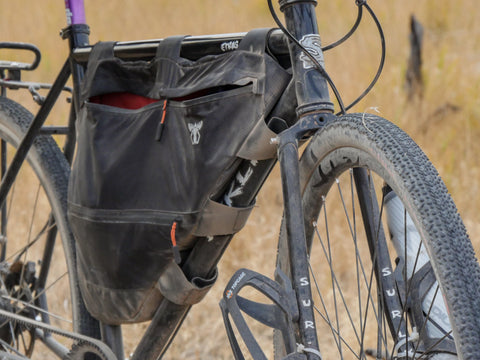Surly Bike Build: VEER's Split Belt Pro Goes Touring On a Surly Straggler 650b

Bike Build:
Surly Straggler Featuring VEER Split Belt™Pro
Veer's Creative Director, Kayla Lopez, and her cycling buddy, Francie, will be embarking on a 7 day, 360+ mile Split Belt Pro Tour to the Oregon Outback! Francie will be atop a trusty Surly Straggler 650b fitted with the Split Belt Pro. We were stoked to finally fit a Surly Straggler with our belt drivetrain! We have gotten a lot of inquiries from the Surly community about converting to our belt drive system and were excited to see how it would work out. The bike came to us as a full build, making it an easier build than the Sage, but we still modified the bike significantly. Here’s the down and dirty for this build (arrows represent changes) .
- Surly Straggler 650b Frame and Fork
- Sram Rival 2x11 → Alfine 11 speed
- VEER Split Belt Pro Conversion Kit. Composed of 32T Alfine rear cog and 64T front ring for 4-bolt 104 BCD spider.
- Sun Ringle Inferno 650B → 700c Alfine rear (yep, it works) and Shutter Dynamo front hub
- Sram Rival Hydraulic 160mm Disk Brakes → Magura MT8 160mm Hydraulic Disk Brakes
- Drop Bars → 735 mm Flat Bars
- Thompson Stem
- Crank Brothers Egg Beater Pedals
- Sram Rival Crankset with 5-Bolt 130 BCD spider
- WTB Horizon 650B x 47c → Clement X’plore m50 700c x 40
- Diety Seatpost
- Brooks Leather Saddle
- Giant Grips
- TLC
Wheally?
From the beginning of this build, we wanted to run an Alfine internally geared hub with the belt drive. We’ve had a lot of interest in the Alfine paired with Split Belt and wanted to pit it against the Rohloff in tough conditions. Also, we already had an Alfine 11-speed laced up in a wheel we were using for commuting to work (Split Belt driven of course).

We thought using this wheel for the Surly was a good plan until we got the bike and realized the Straggler comes with 650b wheels and ours were 700c. Surly builds bikes in a way that aims to allow for unrestricted personalization.
Fortunately, tire choice must have been high on their list because they left loads of room for whatever tires you want to throw on it. This means there was enough clearance for the 47c tires that Francie was running with her 650b wheels. It also meant we could put some slightly smaller 40c tires on our 700c Alfine wheel and still have about ½” to spare!

40c tires are more or less as large as you can get away with while using the 700c wheels because the rear horizontal dropouts load from the front, not the rear, and the tire just touches the frame as you load the wheel. If you really want to fit larger tires, you could deflate and re-inflate the wheel to make it happen.
The rear dropouts have a drivetrain tensioning screw, making for easy belt tension adjustment, and washers that fix the axle rotation of the Alfine were a great fit. This meant there was no need for our belt tensioner or any fancy bracket to fix the rotation of the axle.

The Alfine 11 has a 409% gear range vs. the 526% range of the Rohloff. The Rohloff is also geared substantially lower throughout its range, making it better for steep climbs with a loaded down touring bike. We still wanted to see how it would perform in the Outback running near the low limit of Shimano’s recommended drive ratio (somewhat at the expense of Francie’s legs).
Flat Out
The Shimano Alfine comes with a thumb shifter that is not compatible with the Sram Rival shifters that Francie uses on her drop bars. We considered taking the bar tape off of the drop bars and mounting the thumb shifter just under the brake lever, but decided that would be kind of a pain, and not all that professional or ergonomic. Francie is tough and was confident she’d be plenty comfortable on some standard flat bars. This made mounting the shifter super easy. We also swapped in some lightweight Magura MT8 brakes for the Rival brakes.

Alfined That Belt Line
The Alfine chainline lies much closer toward the centerline of the bike than that of the Rohloff (42.7mm vs. 57mm). If we offset the rear belt sprocket inward we not only increase the likelihood of the front belt ring rubbing on the chain stay, but the rear sprocket will also hit the hub body. If we try to offset the rear belt sprocket away from the centerline of the bike, the sprocket will have a less than pleasant interaction with the shifter cable that comes into the Alfine hub. The distance between the hub body and the shifter cable is roughly 17mm and our belt is 14mm wide, seriously limiting our options for rear belt line adjustment and offset.
This restriction means that we were forced to move the front belt ring inward to obtain the optimal belt line on the Straggler. After spacing the front ring inward by 1.5 mm there was about 2 mm of space between the frame and the front ring. This is close, but also pretty impressive considering the Straggler can accept such wide tires. This was only really possible because the chain stay near the front ring is ovalized to make it narrower (they just smash it a little bit, yay steel). We actually mounted the belt ring on the inside surface of the crank spider and added the 1.5mm offset spacer, whereas the Rohloff was mounted to the outside surface of the spider plus offset spacer. This means that the belt line difference between the two hubs is both of the spacers and the thickness of the spider all added together. That’s a pretty significant difference!
Once we had the belt line sorted we simply threaded the belt through the rear triangle of the frame, inserted the rivet pins, and riveted them together. Then we installed the rear wheel and gave the belt some tension with the tensioning screws. It's important to note that the rotation locking washers for Alfine come in different angles. These set the position of the cable arm coming off the hub with respect to the dropouts. Make sure to use the correct washers for your dropouts!

The Straggler is a versatile, mold-to-your-needs sort of bike. Kinda like your freshman year of college when you didn’t know where to go so you just tried everything out. Anyone? Just me? Cool. This Straggler has been on all sorts of pavement touring adventures but we were about to unleash it’s gravel bikepacking majesty. Other than some other minor adjustments the bike was ready for racks, bags, and touring galore.

Author: Daniel Hacking
Photography: Kayla Lopez

